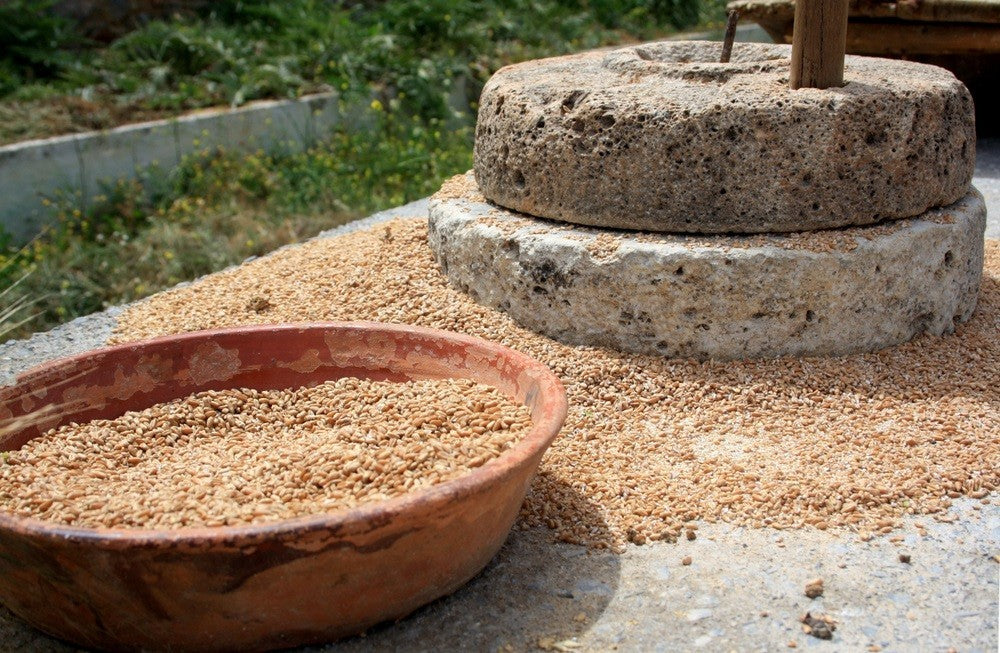
Stoneground flour is whole grain flour produced by traditional grinding methods between two stones (Chakki).
Stoneground flour is usually used in bread but not in cakes and pastries because of its high oil and protein content. It is also used to make chapatis and delicacies that have better texture and taste.
Historically, when there was no electricity, stone-milling was the way to produce flours. But rollers took their place, and that’s how we got to the mass-produced flours today. The resurgence of stone ground flours has come about as people have become more health-conscious.
That brings us to the following question: Is stone ground flour healthier than the regular mass-produced flour?
Is Stone Ground Flour healthier?
Stone Ground flours are not only healthier because the slow grinding process ensures that the flour contains the germ and bran also slow grinding helps in enabling to retain the , which are usually “cooked away” because of the heat in the mass-produced roller flours, but this germ and bran also make the stoneground flour tastier! (the taste might be too intense for some consumers)
The bran contains proteins, antioxidants, vitamins, and fibers, crucial to maintaining a healthy digestive system. The germ contains B1 and B2 vitamins, minerals (like Calcium, Zinc, Magnesium, and Potassium), and essential fatty acids for healthier brain functionality.
The stoneground flour is also full of endosperms that provide starches, carbohydrates, protein, iron, and B vitamins. With so much nutrition packed in stone ground flour, what is the reason not to consume it?
What are the benefits of consuming Stone ground Flour?
Stoneground flour is often sourced from farms that use organic practices for cultivation. It contains dietary fiber content, which is beneficial for people with diabetes and for people who want to lose weight.
Weight loss
The products containing The mass produced flour are usually junk foods like bread, pasta, cookies, cakes, etc. But that’s not the only reason for gaining weight.
The mass produced flour doesn’t contain the micro and macronutrients which are essential to feeling “full.” Thus, we often consume more flour than required which leads to weight gain. Stoneground flour contains all those nutrients, thereby helping in weight loss.
The mass produced flour doesn’t contain bran and germ, which means it only has starch.
Good for Diabetic Patients
The mass-produced flour contains endosperms that shoot up the body’s sugar levels. Research shows an increase in Type 2 diabetes with the rise in consumption of the mass produced flour.
Stoneground flour also contains endosperms, but it also includes other dietary fibers that help balance the effect of the starch content.
Because of the fibers and the low glucose content, it also prevents inflammation and improves digestion.
How is Stone Ground flour produced?
The Chakki mill uses two stones – one is kept stationary at the bottom (called bed stone), and the other is kept above it (called runner stone).
Grains are poured through the hopper. The runner stone slowly grinds the grains to ensure less heat production. It breaks the starch to release sugars and adds to the experience of consuming stoneground flour.
The flour we finally get is slightly yellowish because of the dietary fibers, carotene, and no added preservatives
Conclusion:
What’s the point of avoiding stone ground flour when it has so much nutrition?Traditional flour grinding offers benefits beyond health! The low temperature grinding aids in the preservation of aroma, flavour, and nutrients.You can now order the stone ground flour from here.
